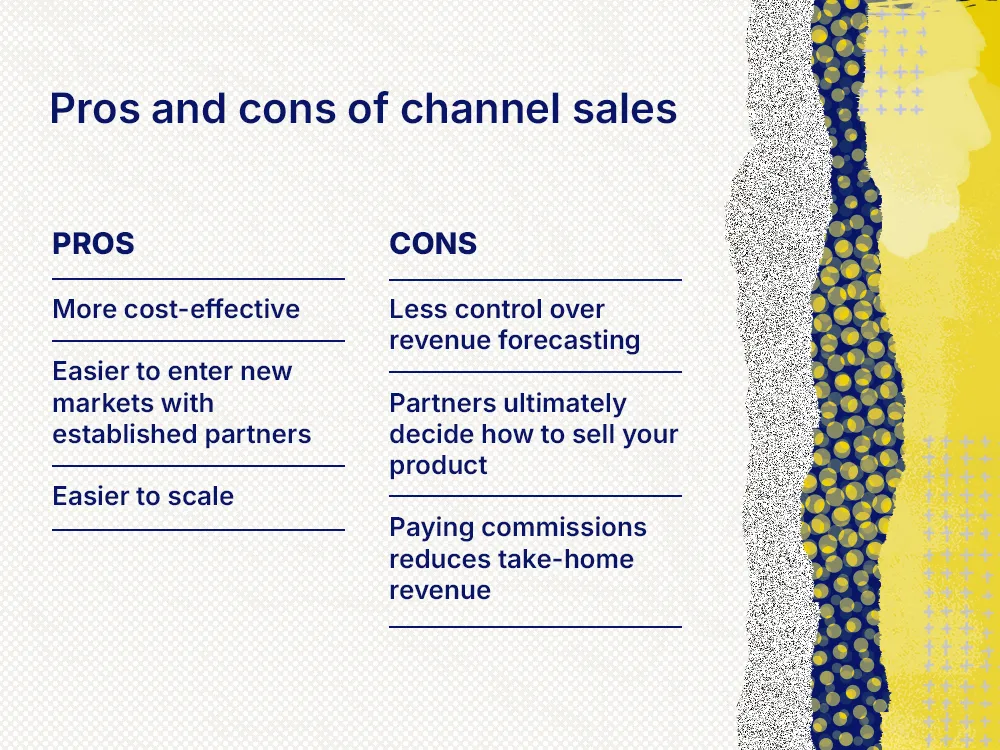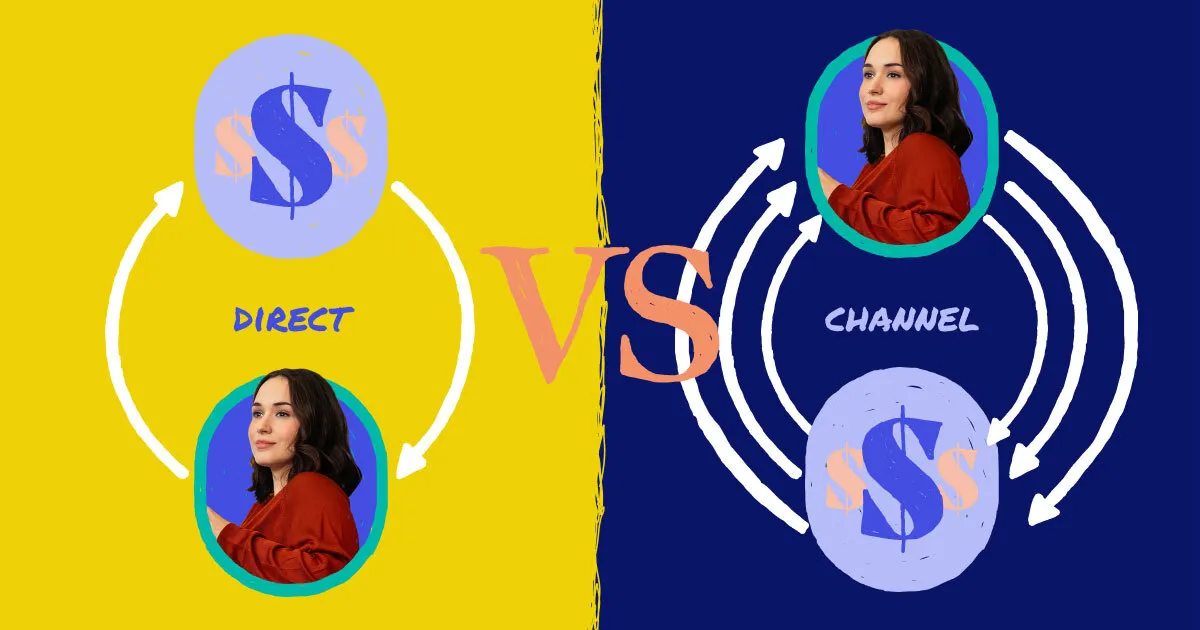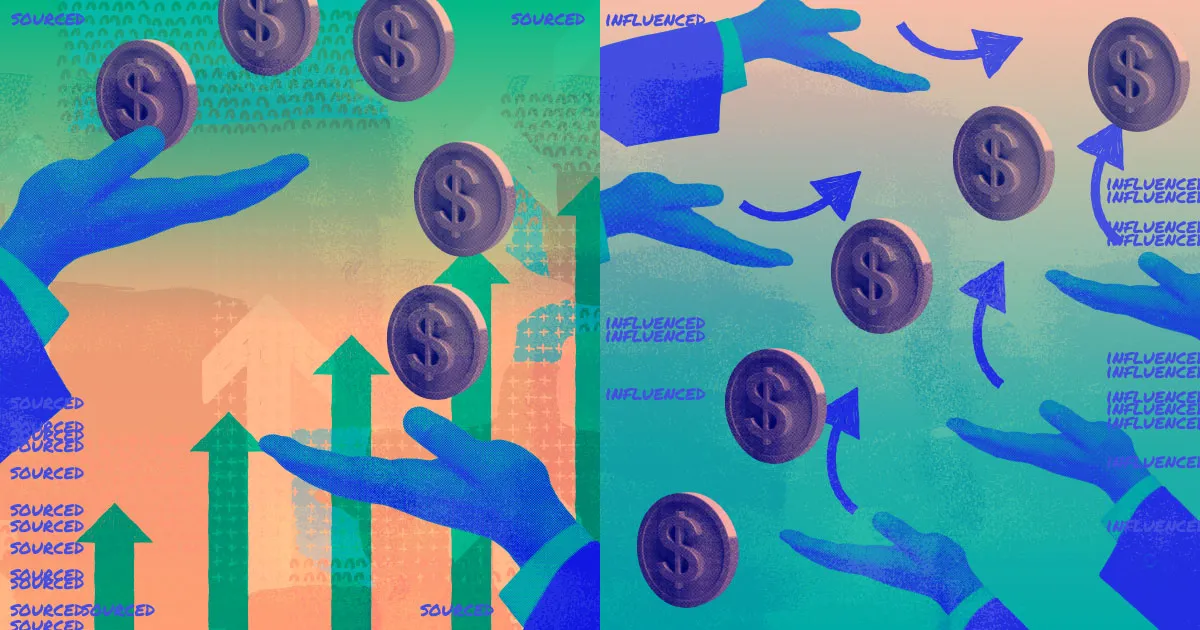Every business needs sales to grow. You already know that. But what sales channel strategy should you use?
In B2B SaaS, two of the most common sales channels are:
- Direct sales: the traditional model where your internal team manages the entire sales process.
- Channel sales: where external partners help sell your product.
Both strategies work, but they require different resources, follow different sales processes and create very different customer journeys. So how do you choose the right one for your business?
We spoke with Nikita Zhitkevich, VP of Sales at PartnerStack, to break it down. In this article, we’ll cover:
- How direct sales vs. channel sales work in B2B SaaS
- The pros and cons of each sales strategy
- How to choose the right model for your business in 2025
What is direct sales and how does it work?
As the name suggests, direct sales is when a company sells directly to its customer base without a middleman or retailer, using in-house sales reps. There is an immediate relationship between the customer and the company, whether that is through face-to-face meetings, phone calls, social media or video conferences.
In a direct sales model, the company manages the entire sales cycle. That includes hiring and training a sales team, building a marketing and lead generation engine, and managing customer relationships, from first touch through onboarding and support.
Direct sales drives results because it allows companies to build trusted, one-to-one relationships with their buyers — something that’s critical when selling high-value or complex SaaS products or using high-touch sales models. A dedicated sales rep can guide prospects through the decision-making process, address objections in real time and tailor the pitch to the customer’s specific needs or pain points. This increases the chances of closing the deal.
It also shortens the feedback loop. Because your team is speaking directly with buyers, you can quickly spot patterns in objections, pricing concerns or product questions and adjust messaging or even product features in response.

What is channel sales and how does it work?
Channel sales differs from direct sales because third parties play an active role in the sales cycle, making it a form of indirect sales. Instead of selling directly to customers, a SaaS company partners with resellers, affiliates, service providers or marketplaces who sell the product on its behalf.
In SaaS, companies often run channel sales through reseller programs, OEM agreements, service partners, affiliate programs or marketplaces. Partners manage much of the sales motion, but the company still engages customers for onboarding, support and renewals.
When you use the channel sales model, you don’t manage the entire sales cycle yourself. Instead, you focus on building a strong channel sales strategy: training partners, giving them marketing collateral, setting clear pricing and commission structures and offering incentives that make selling your product worthwhile.
This approach has gained increasing popularity in recent years because rising customer acquisition costs (CAC) and the shift in search behavior driven by AI have made partnerships a cost-effective way to reach buyers. “A lot of folks are leaning into partnerships because ultimately it’s easier to come in from a warm introduction than from just a cold outbound in a lot of situations,” Zhitkevich explains.
And it works. According to the State of GTM in 2025 report from Iconiq Capital, surveyed B2B SaaS companies derived a significant portion of their revenue — often 20 per cent or more — from channel sales between 2023 and 2025.
Another reason more companies are investing in channel partnerships is the visibility in AI-driven search results and large language models (LLMs) that it grants. When buyers turn to tools like ChatGPT to ask which products are best for them, those recommendations often draw from content that partners have already created like reviews, comparisons and product listicles.
“Affiliate partners can also help you rank in large language models, so your product surfaces in AI-driven recommendations much sooner,” Zhitkevich says.
You might also like: AI is reshaping affiliate marketing — here’s how leaders are adapting.
The differences between direct sales and channel sales
Let’s break down some of the key differences between these sales tactics:
Who sells
Direct sales: Internal sales team (SDRs, AEs, account managers)
Channel sales: External partners such as resellers, affiliates, value added resellers (VARs)
Customer relationship
Direct sales: Company owns the full relationship and communication
Channel sales: Partner manages most of the relationship, but company may still handle onboarding, support or renewals
Sales cycle control
Direct sales: Company has full control over the entire sales process
Channel sales: Shared control, as partners manage parts of the cycle
Scalability
Direct sales: Limited by size of your internal team
Channel sales: More scalable. Partners can expand your reach without growing headcount
Effort required
Direct sales: High. Company manages prospecting, selling, onboarding and support
Channel sales: Medium. Company manages partner enablement, training and performance

The pros and cons of direct sales
Here are some of the pros and cons to consider if you want to use this sales strategy:
Pros
- Control of the entire sales cycle. You manage everything: hiring, marketing, training and customer service.
- You get to keep all the profits from the product since you don’t have to pay affiliate fees or commissions. This also makes it easier to forecast revenue growth.
- Immediate access to customer feedback thanks to a direct line of contact.
- Faster sales process iteration. You can test and adjust tactics quickly without relying on third-party coordination.
- You avoid the complexity of recruiting, vetting and enabling channel partners.
Cons
- It’s harder to scale when you own the entire process. You’re responsible for all the hiring, marketing, research, feedback, iteration and customer service.
- Higher costs as you’re responsible for everything from the hiring process to the CRM platform.
- Harder to enter new markets and reach new customers compared to channel sales, which may have affiliates already in those spaces.

The pros and cons of channel sales
Just like direct sales, channel sales has its pros and cons to consider:
Pros
- More cost-effective. Instead of hiring and scaling an internal sales team, you can work with partners who already have the infrastructure and customer relationships in place.
- Easier to enter new markets and reach target markets, as it’s simply a matter of finding new affiliate partners already established in that market.
- Easier to scale as you can find new third parties to help with the process.
Cons
- Less control over revenue forecasting as it depends on reporting from vendors and the transparency of the process.
- Less control over the marketing and selling of the product. You can provide training and collateral, but partners ultimately own how they position and sell your product.
- You’ll need to offer partner discounts or pay out affiliate commissions, which reduces your take-home revenue.

How to choose between direct sales and channel sales
There are so many factors to consider when trying to decide between direct sales and channel sales. The right choice depends on your business model, product, stage of growth and target market.
A direct sales model makes sense if:
- You’re early stage (under $1M ARR). Zhitkevich advises owning the sales cycle in the early days, so you can learn how customers buy and use your product and innovate quickly. “Once you’re past the $1M ARR mark and have strong product-market fit, that’s when you can start meaningfully leveraging partners to scale,” he says.
- You’re selling enterprise-grade or complex software that requires a high-touch sales motion.
- You already have an in-house sales team ready to prospect, run demos and close deals.
A channel sales model makes sense if:
- You’ve already proven repeatable sales and are looking to scale revenue without significantly increasing headcount.
- You want to enter new markets faster by leveraging resellers, affiliates or service providers with existing customer relationships.
- Your CAC is rising, and you need more cost-efficient ways to reach buyers.
That said, you don’t have to pick one over the other. Many SaaS companies use a hybrid model that blends both sales channels. “There’s a strong symbiotic relationship between direct and channel sales,” Zhitkevich says.

Combining direct sales and channel sales
Today, many SaaS companies run some form of hybrid model. “What I’m seeing across the board now is as partnerships continue to develop, there are a lot more types of partners, and many of them actually feed and support direct sales as well,” Zhitkevich says.
Partnerships generate opportunities at the top of the funnel — through affiliates, referral partners or customer referrals — then route the leads into the direct sales team, which works the opportunity while the partner still gets credit for sourcing it.
This creates a more efficient use of resources. Instead of relying solely on outbound efforts, direct reps spend more of their time closing warm leads that partners helped generate. “Instead of sending those sales reps out to sell direct, they’re now working hand-in-hand with channel partners to sell to a much wider scale of customers,” Zhitkevich adds.
The result is a hybrid model where channel sales expand reach and fill the pipeline, while direct sales nurture, close and grow those accounts.
How to create a channel sales strategy
Creating the strategy is a multi-step process. After assessing that channel sales is the right growth strategy, do the following:
- Vet third-party vendors to see if they are the right fit. This means defining your partner profile with attributes like audience, product alignment and proven influence. “Start by asking where your customers already go today and which partners they trust. Map the existing buyer journey and identify where a partner can add real value. That’s how you know if they’re the right fit,” Zhitkevich explains.
- Train your vendors. You want them to be enthusiastic and knowledgeable about your product. Start by letting them know the benefits of working with your products, because everyone wants to know what they’ll get out of a business relationship. Offer ongoing training, provide access to success metrics and maintain transparency with updates and communications. This ongoing management is why you might want to hire a channel sales manager or partnership manager to find the right partners and maintain the partner relationships.
- Empower your vendors to adapt strategies as they sell your product (within brand guidelines, of course). Learning is a two-way street, and third-party vendors can provide learning and customer feedback that can be used to adapt channel sales strategies.
Note: If you’re just starting out in channel sales, you likely won’t have the budget or bandwidth to work with large channel sales partners right away. Zhitkevich recommends starting with partners that can deliver quick wins — such as affiliates, customer referral partners or agencies — to drive pipeline and prove out the partner-led motion. Once you’ve built a more established partner base, you can expand into relationships with resellers and distributors.
Read more: Empower partners through learning paths.
FAQs for direct vs. channel sales in B2B SaaS
What is the difference between channel sales and direct sales?
The key difference is who sells the product. In direct sales, your in-house team manages the full sales cycle from prospecting and demos to closing deals and supporting customers. In channel sales, third-party partners, such as resellers, affiliates, agencies and marketplaces, sell your product to their own audience and often manage parts of the sales cycle.
Which is better: direct or channel sales?
Your choice depends on your business stage and goals. Direct sales works best for early-stage SaaS companies and products that require a high-touch approach. Channel sales works well once you’ve achieved product-market fit and want to scale faster or enter new markets. Many SaaS companies use a hybrid model that combines both.
What does a channel sales manager do?
A channel sales manager oversees partner relationships and ensures the success of your channel sales program. Their responsibilities include recruiting and vetting new partners, providing onboarding and training, supplying marketing collateral, setting commission structures, monitoring partner performance and maintaining communication to keep channel sales partners engaged and motivated.
Is SaaS better suited for channel or direct sales?
B2B SaaS can succeed with either approach, depending on the target customer. Enterprise SaaS often relies on a direct sales model because deals are complex and relationship-driven. SMB SaaS frequently benefits from channel sales, where affiliates, agencies or marketplaces can distribute at scale. Many SaaS companies eventually combine both approaches to cover different segments of their customer base.
What are examples of a channel sales strategy?
Examples include:
- Affiliate programs where individuals or businesses earn commission for driving new signups.
- Referral programs that reward existing customers for bringing in new leads.
- Value-added resellers (VARs) who package your SaaS with other services.
- Partners or agencies that implement your SaaS for their clients.
- Marketplaces where customers can purchase your product through trusted platforms.
You might also like: Revenue-driving partnerships in action: real-world case studies.
How PartnerStack can help manage your channel sales program
Direct and channel sales both play an important role in SaaS growth. Direct sales keeps you close to customers and helps refine your product and strategy, while channel sales expands your reach and allows you to scale revenue growth.
PartnerStack makes it easier to build and grow a channel sales program that actually drives revenue. From recruiting and onboarding the right partners to automating payouts and tracking performance, PartnerStack gives you the tools to manage your partner program end-to-end. Plus, with access to the PartnerStack Network of 120,000+ active B2B partners, you can accelerate growth by connecting with partners who are ready to promote your product.
Ready to scale your SaaS revenue with partnerships? Book a demo today.

















